Boasting six national parks, including the majority of Yellowstone, there’s no end of majestic places to see ducks in the ‘Cowboy State’.
There are at least 20 species of duck that permanently reside or pass through Wyoming at various times of the year, and many of them are truly spectacular birds to behold.
Let’s take a plunge together, then, into the watery world of ducks in Wyoming.
Ducks in Wyoming
20 species of ducks, listed in order of how likely you are to see them during the spring and summer months.
Mallard

- Scientific Name: Anas platyrhynchos
- Length: 19.7 – 25.6 in
- Weight: 35 – 45 oz
- Wingspan: 32.3 – 37.4 in
Yes, the ubiquitous mallard is the most common duck species in Wyoming – and by quite a long way!
They’re spotted by at least 1 in 5 bird watchers in the state, not only during the summer but in the winter too! Mallards are big, robust dabbling ducks that overwinter throughout the United States and even Southern Canada too.
While they’re the most common and widespread of all duck species in the United States, we mustn’t forget how beautiful Mallards are. A male Mallard, in his breeding prime, has an incredibly handsome, iridescent green head, well defined by a white collar and gorgeous orange legs.
Females are less colorful but have a lovely bright blue patch on the wings, and who could resist her signature ‘quack-quack-quack’?
Mallards are also one of the longest-lived duck species, and have been recorded to live for at least 27 years!
Gadwall
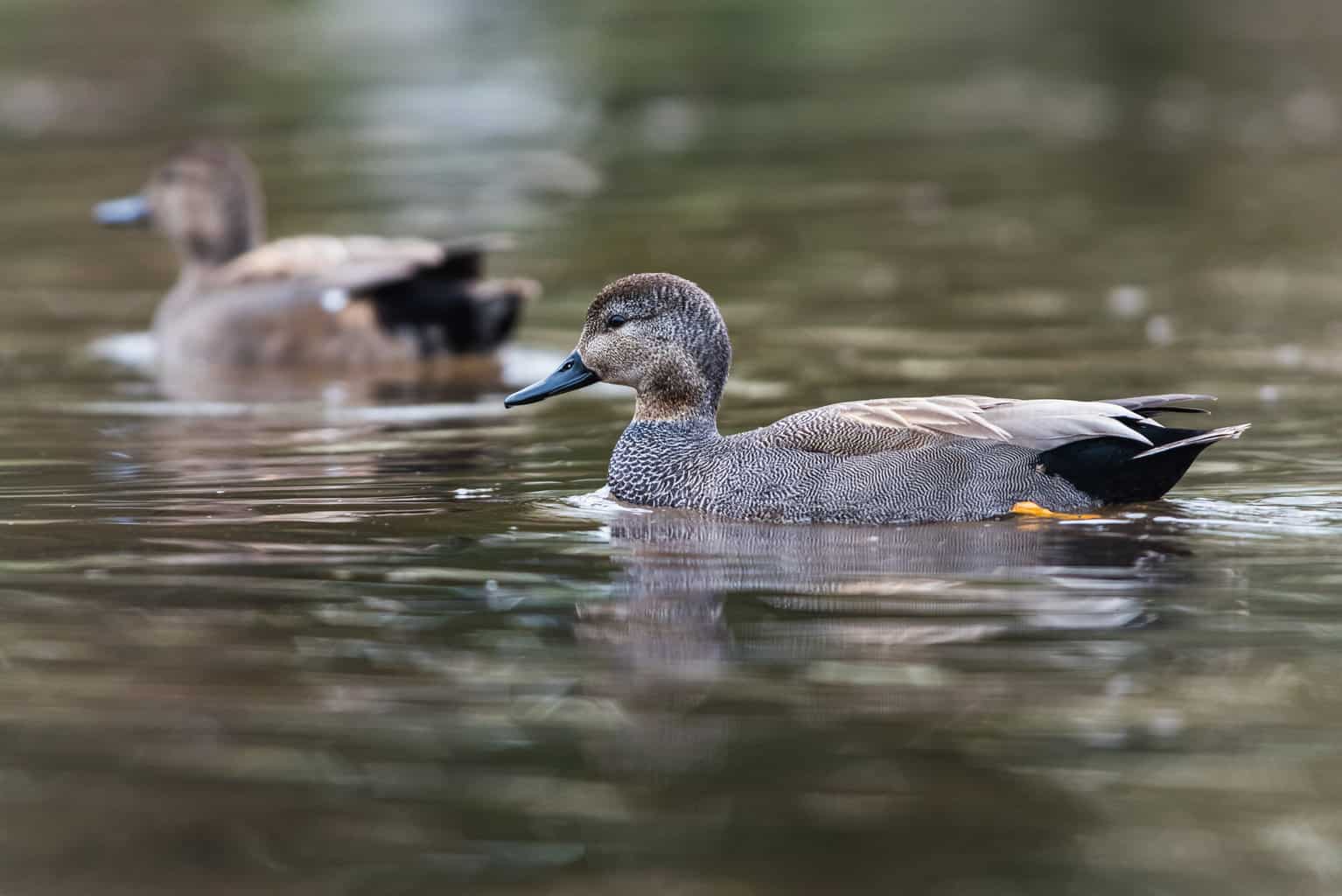
- Scientific name: Mareca strepera
- Length: 19 – 23 in
- Weight: 29 – 35 oz
- Wingspan: 31 – 36 in
Gadwalls are large dabbling ducks that move around different parts of Wyoming state during different parts of the year.
During the breeding season, South Wyoming is one of the most important breeding grounds for these ducks in the United States. Huge numbers of them also pass through the state in spring and fall on their way to and from other breeding grounds in Canada. In the winter months, their populations are confined mostly to the southwestern corner of the state.
Gadwalls are fairly modest in their plumage compared to many of the state’s other duck species. The male has various tones of gray across his body, with a darker head, beak, and black tail feathers. The females have an attractive mottled brown pattern across their backs and may be confused with female Mallards from a distance.
This dabbling duck loves to eat submerged vegetation, but will also steal food from diving waterfowl like coots when they surface. At nearly 40 oz, smaller birds don’t tend to answer back!
Common Merganser
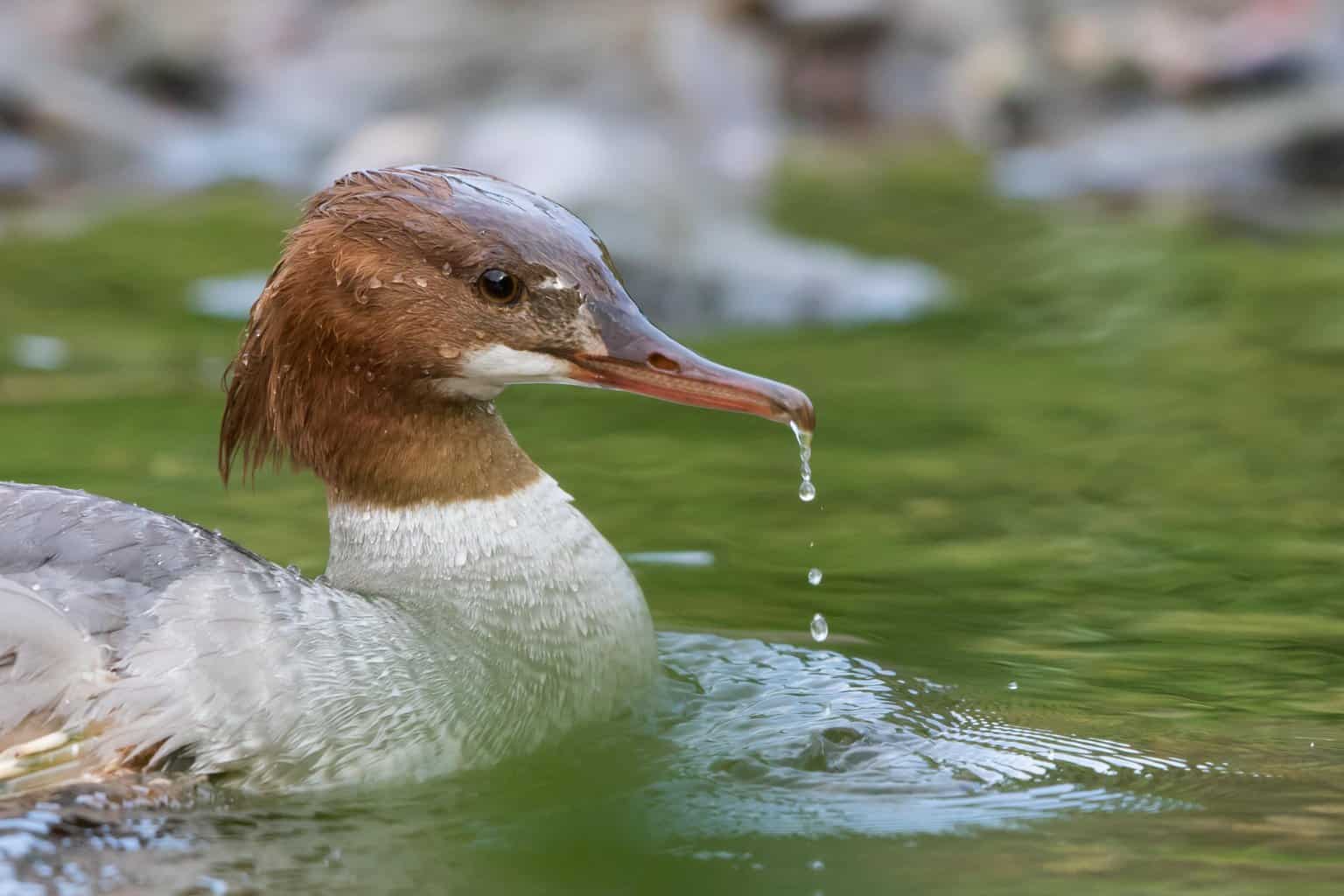
- Scientific Name: Mergus merganser
- Length: 22 – 27 in
- Weight: 45 – 60 oz
- Wingspan: 31 – 37 in
Common Mergansers can be seen at various times of the year almost everywhere in Wyoming State.
Males have a white body with a striking black throat and head, and bright orange-red beak. Females are also attractive with white bodies and brown, tufted heads.
These large diving ducks are very agile in the water and love to eat fish. Their long, serrated beak is the ideal instrument for this, but they’ll also dig around for mollusks, insects, crustaceans, and worms.
Their skill at catching fish sometimes earns them unwanted attention from other waterfowl who will occasionally try to steal a meal from their mouths!
Cinnamon Teal
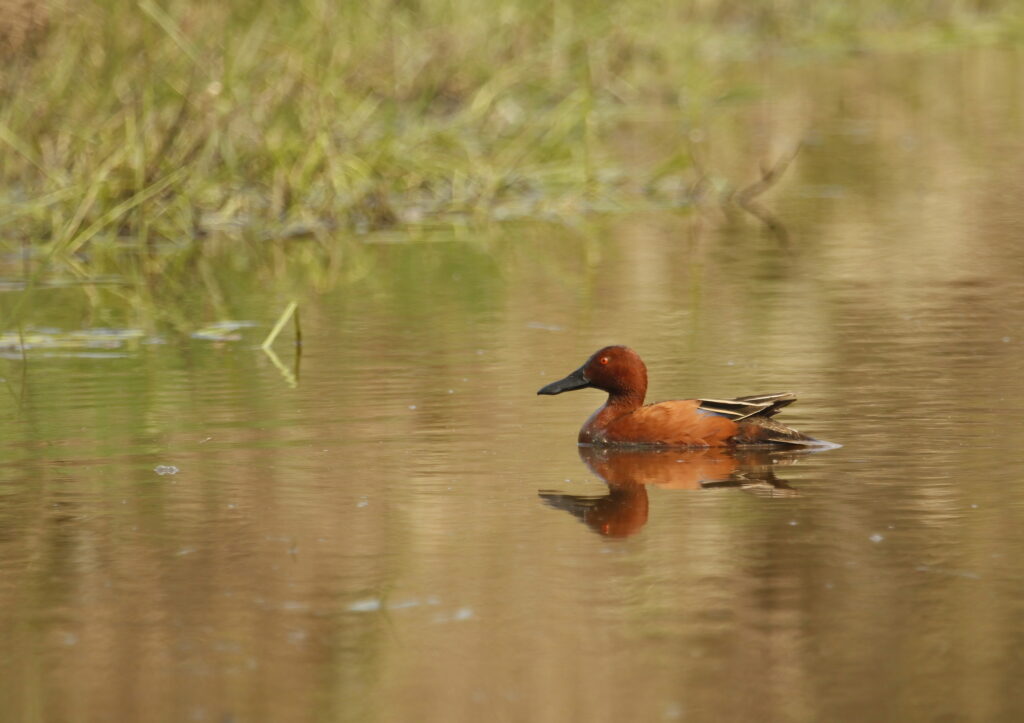
- Scientific Name: Spatula cyanoptera
- Length: 14 – 17 in
- Weight: 11 – 16 oz
- Wingspan: 24 – 30 in
Cinnamon Teals are closely related to shovelers and this can be seen in their stout bills which are adept at skimming shallow water for tasty morsels. The male’s plumage is largely cinnamon-red, with beautiful blue and green wing feathers only visible in flight.
Sadly, the number of Cinnamon Teals has been declining over the past 50 years due to habitat loss. These birds need large, permanent wetlands to thrive, which have been disappearing due to human development and modern farming.
Luckily Wyoming still provides a sanctuary for these birds and they can still be frequently seen during the breeding season in marshes as well as inland lakes and shallow ponds.
American Widgeon

- Scientific Name: Mareca americana
- Length: 16.5 – 23.2 in
- Weight: 19 – 46 oz
- Wingspan: 33.1 in
Also known as ‘Baldpates’, American Wigeons are a dabbling duck species found throughout most of North America.
The breeding male is a handsome bird, with shiny-green mask-like feathers around his eyes, and a cream cap. In the winter his plumage is much more subdued. The female is altogether more modest, being mostly gray and brown, and distinguished by other ducks only by her shape.
American Wigeons can be seen throughout the year in Wyoming, and frequently breed in the north of the state – the southernmost point of their main breeding grounds. Blacktail ponds and The Swan Lake Flats are good places to see this bird.
American Wigeons can be shy and difficult to spot, but you may be more likely to hear them! The male has a surprisingly loud high-pitched nasal whistle, while the female offers a more familiar harsh grunt of a quack.
Lesser Scaup
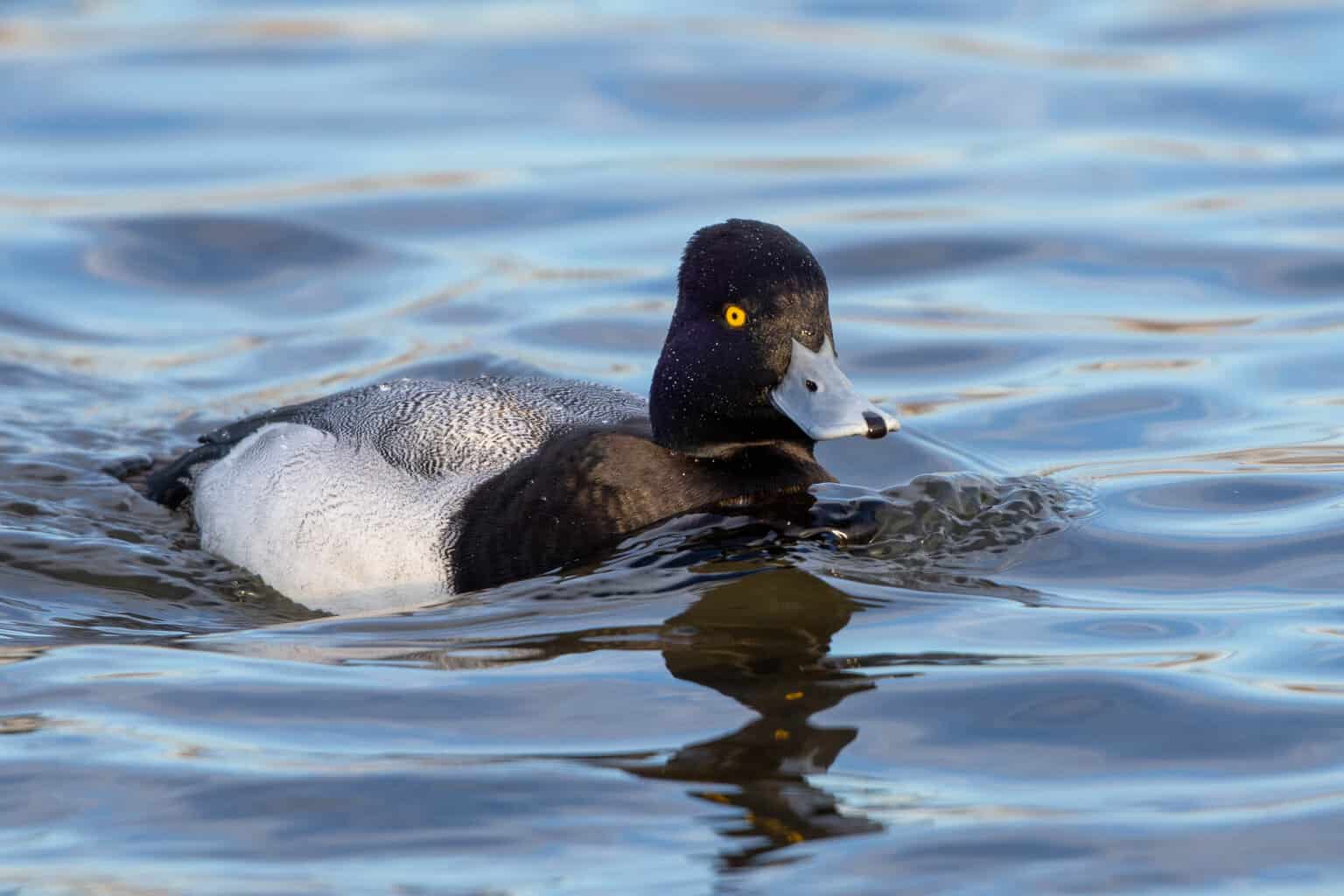
- Scientific Name: Aythya affinis
- Length: 15 – 18 in
- Weight: 32 – 40 oz
- Wingspan: 24 – 33 in
The Lesser Scaup is one of the most numerous expert diving ducks in North America, although populations have been declining significantly in recent decades. Sadly, the issue is difficult to address because the reason behind their demise has not yet been fully understood.
Lesser Scaups are medium-sized diving birds and close relatives of the Greater Scaup, which are not present in Wyoming. The two species can be distinguished by the tufts of hair at the tip of the heads of Lesser Scaups which are lacking in Greater Scaups.
The head, neck, and chest of male Lesser Scaups are black with a purplish sheen. Their golden yellow eyes stand out vividly, and their backs are covered in attractive black and white mottled plumage. Females are mostly dark brown with a distinctive white patch next to their bills.
Lesser Scaups frequently breed in the southern and western-most parts of Wyoming, even if their main breeding grounds are in central and western Canada. They are mostly seen in Wyoming between March and July but can occasionally be seen in the winter in low-lying areas too.
Green-winged Teal
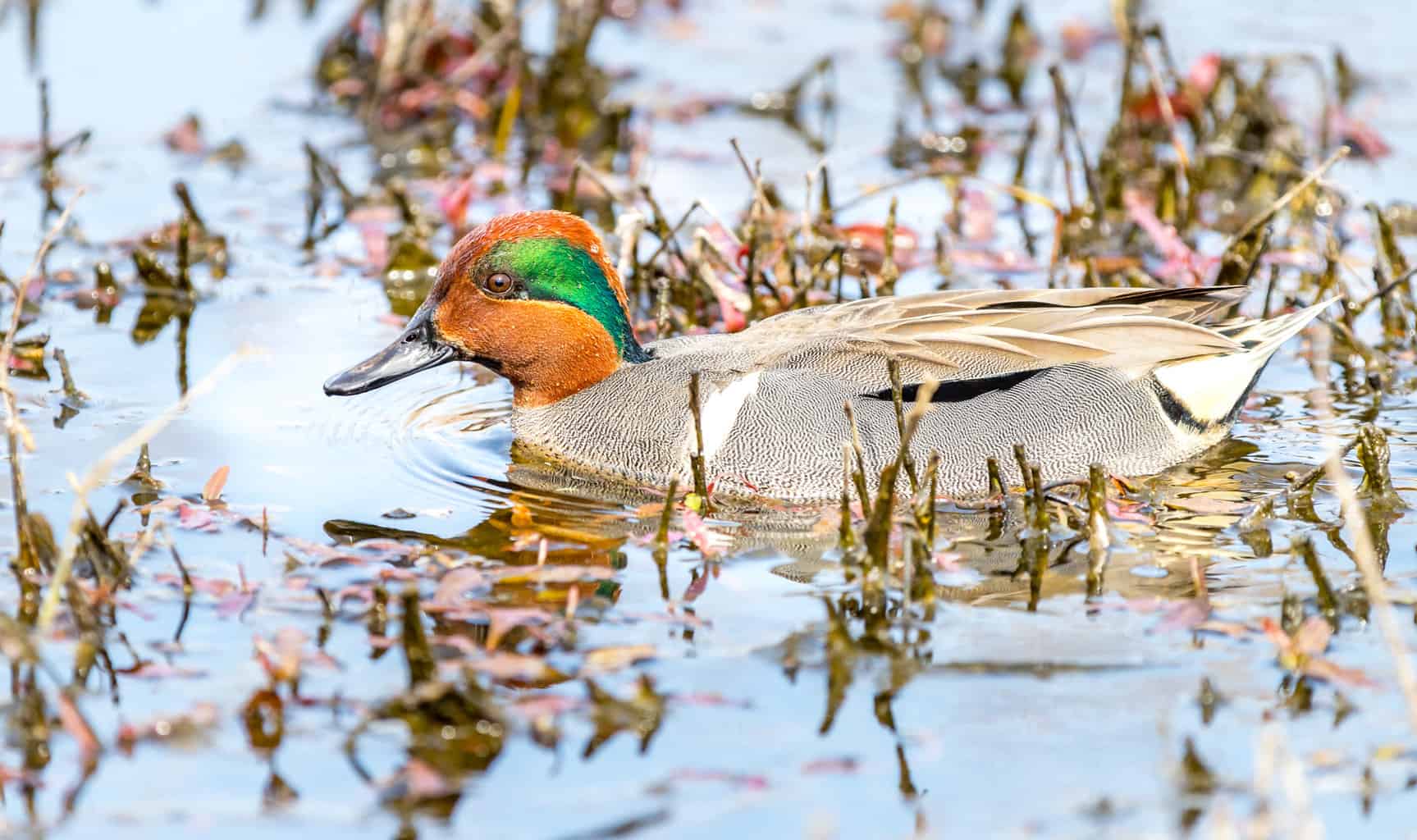
- Scientific Name: Anas crecca
- Length: 12.2 – 15.3 in
- Weight: 6 – 17.6 oz
- Wingspan: 20.5 – 23.2 in
The Green-winged Teal is the smallest of all American dabbling ducks – females can sometimes weigh as little as 6 oz! Despite this, they’re also one of the most hunted.
Wyoming is one of the few states where Green-winged Teals breed and stay overwinter. The state is at the southern end of their breeding grounds, and the northern end of their winter grounds.
Despite this, Wyoming also receives huge flocks of Teals passing through on their migration route too. You’re most likely to see these migrating birds between March-April and October, with flocks numbering up to 50,000 birds.
Both male and female Green-winged Teals can be identified by their small size and distinctive green patch on the end of their wings, which gives them their name. The male also has a beautiful green mask set against a reddish-brown head.
Northern Shoveler

- Scientific Name: Spatula clypeata
- Length: 17.3 – 20.1 in
- Weight: 14.1 – 28.9 oz
- Wingspan: 27.2 – 33.1 in
Northern Shovelers are mostly summer visitors in Wyoming, but a few populations can be found in the very southwest corner of the state during the winter too.
The Latin name ‘Spatula’ as well as the common name given to this family of birds describes their amazing-looking beaks which they literally use like a shovel to dig and sift through the mud in their search for aquatic insects, crustaceans, and mollusks buried in the mud.
Apart from their enormous bills, the males can be recognized by their rusty-brown flanks, dark-green heads, yellow eyes, and bright white chest. Females are brown in color and are most easily identified by the famous beak and blue patch on their shoulders. The beaks are black in males, but orange-brown in females.
Northern Shovelers are known to work together to stir up their favorite food. If you see a flock of them, swimming around frantically in a tight circle together, now you’ll know what they’re up to!
Barrow’s Goldeneye
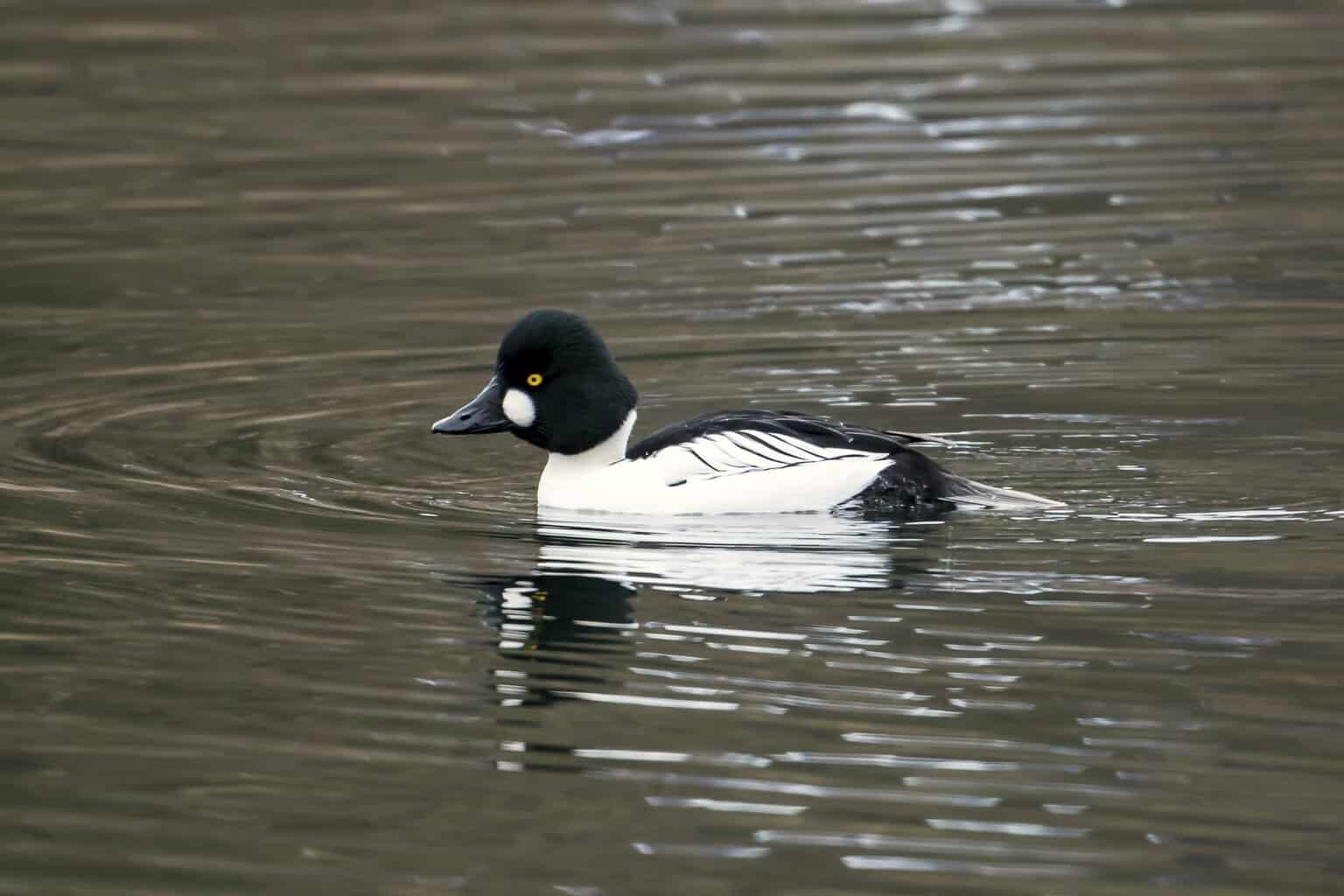
- Scientific Name: Bucephala islandica
- Length: 16 – 20 in
- Weight: 35 – 46 oz
- Wingspan: 30 – 32 in
Barrow’s Goldeneyes are medium-sized ducks that are similar in many ways to Common Goldeneyes, whom they often share flocks with. Since both species can be found in Wyoming you’ll need to know how to tell them apart. Male Barrow’s Goldeneyes have a large crescent-shaped white patch behind their beaks whereas Common Goldeneyes have just a small white circle.
As you’d expect, they have bright, golden yellow eyes and males also come with lovely white chests and bellies set against black plumage on the upper body.
Barrow’s Goldeneyes are more numerous than Common Goldeneyes in Wyoming during the summer but are much less frequently seen here than their cousins in the winter. They’re most commonly spotted in the western part of the state.
During the summer, you’re most likely to see Barrow’s Goldeneyes in small mountain lakes and ponds, without the presence of fish – this is so they can enjoy feeding upon the greater share of the aquatic insects. This species of duck nests in tree cavities and have also been known to use nest boxes.
Blue-winged Teal
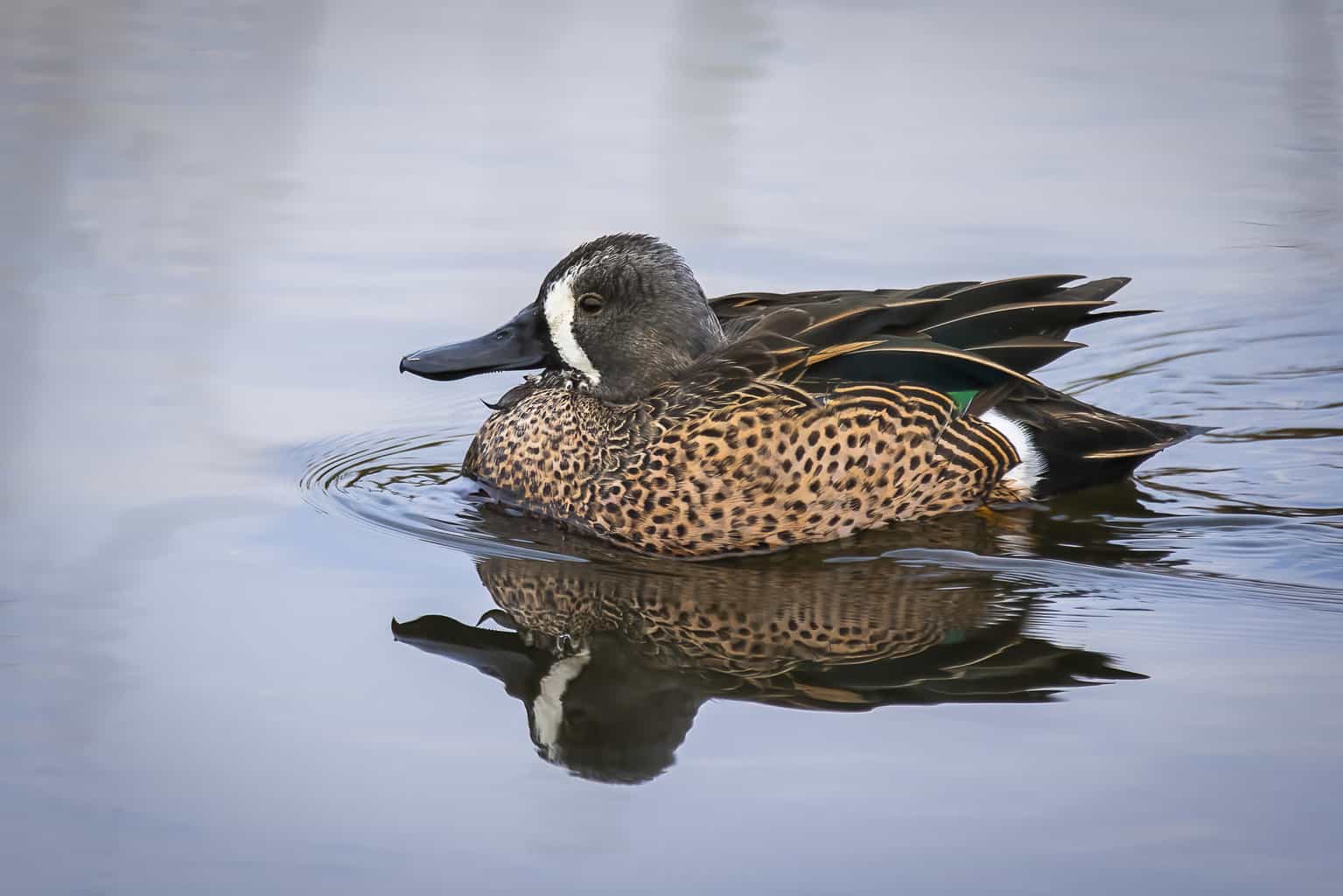
- Scientific Name: Spatula discors
- Length: 15 – 17 in
- Weight: 10 – 19 oz
- Wingspan: 23 – 31 in
Blue-winged Teals migrate to the northern United States each year for breeding but don’t stick around for winter. These warm-loving ducks prefer to overwinter in tropical or subtropical regions, so you’ll only see them in Wyoming during the warmer months.
Blue-winged Teals are the second-most common duck species in North America after the Mallard. The males can be identified by their bluish heads with a white band in front of their eyes. Females have brown bodies with a dark line near their eyes and a crown on their heads. Both males and females have a patch of blue color on their shoulders that becomes visible in flight.
This species forages their food almost exclusively in shallow water, and so rarely up-ends or forages on land. Their diet is mostly vegetarian, and they have an especially keen appetite for the seeds of aquatic plants.
They like to nest in long grasslands, sometimes hundreds of yards from the water, where they can remain concealed until the eggs hatch.
Ruddy Duck
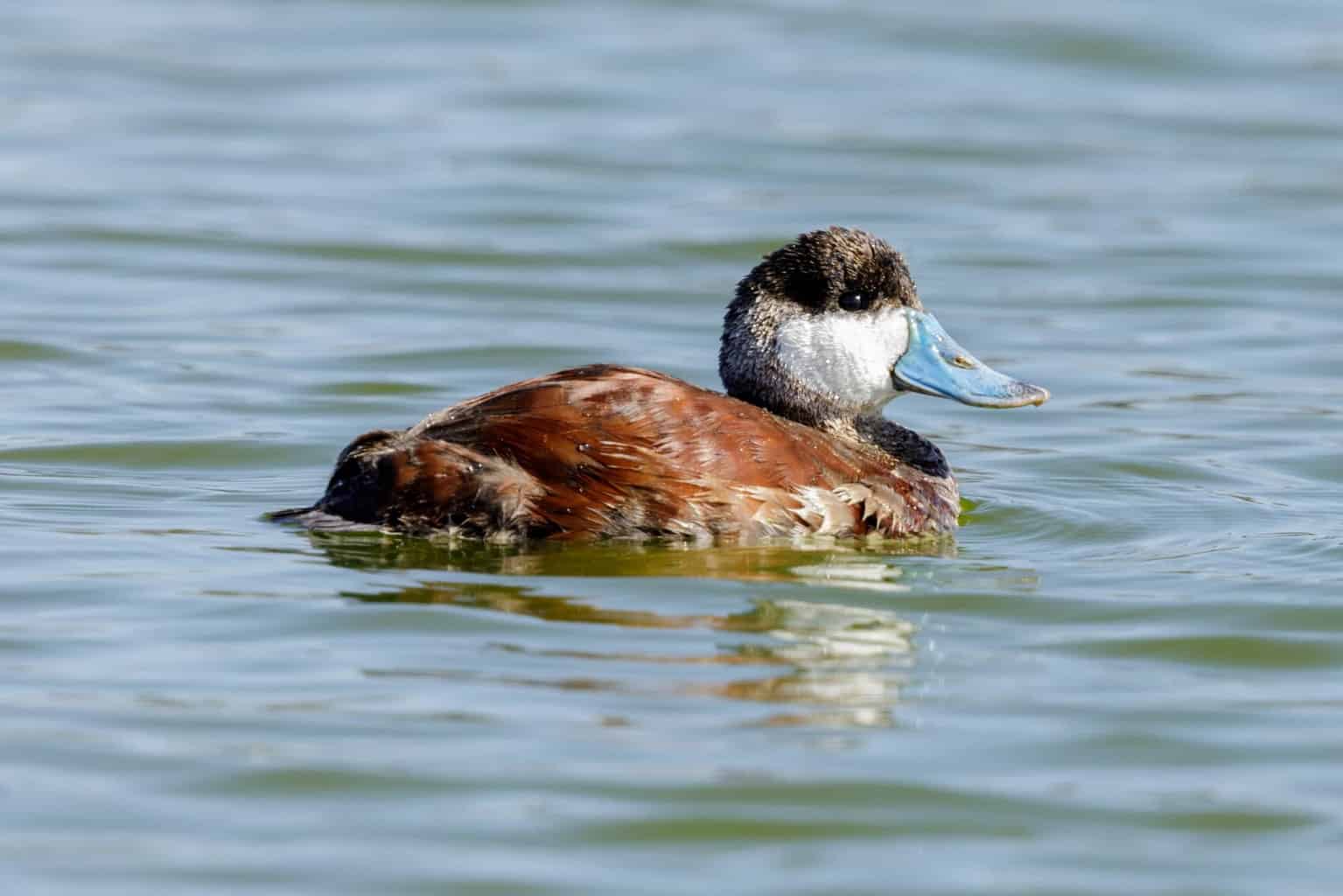
- Scientific Name: Oxyura jamaicensis
- Length: 14 – 16 in
- Weight: 12 – 30 oz
- Wingspan: 21 – 24 in
Wyoming is right in the middle of the common breeding grounds of the Ruddy Duck, which prefer to overwinter in more southerly states.
The plumage of male Ruddy Ducks changes significantly through the season. Whereas the males are dull, gray-brown during the winter, they transform into a rich, reddish-brown for the breeding season. Their heads and neck are black with bright white cheeks and a striking blue bill.
Females have a more subtle dark brown head with lighter plumage around their cheeks. Otherwise, their color is much like the males during the winter season.
In Wyoming, you’re most likely to see Ruddy Ducks in freshwater marshes, lakes, and ponds. This species is a diver that spends much of its time swimming underwater searching for vegetation, insects, and crustaceans to eat.
Ruddy Ducks build a floating nest that they conceal within aquatic vegetation. The young are adept divers from the moment they hatch!
Ring-necked Duck
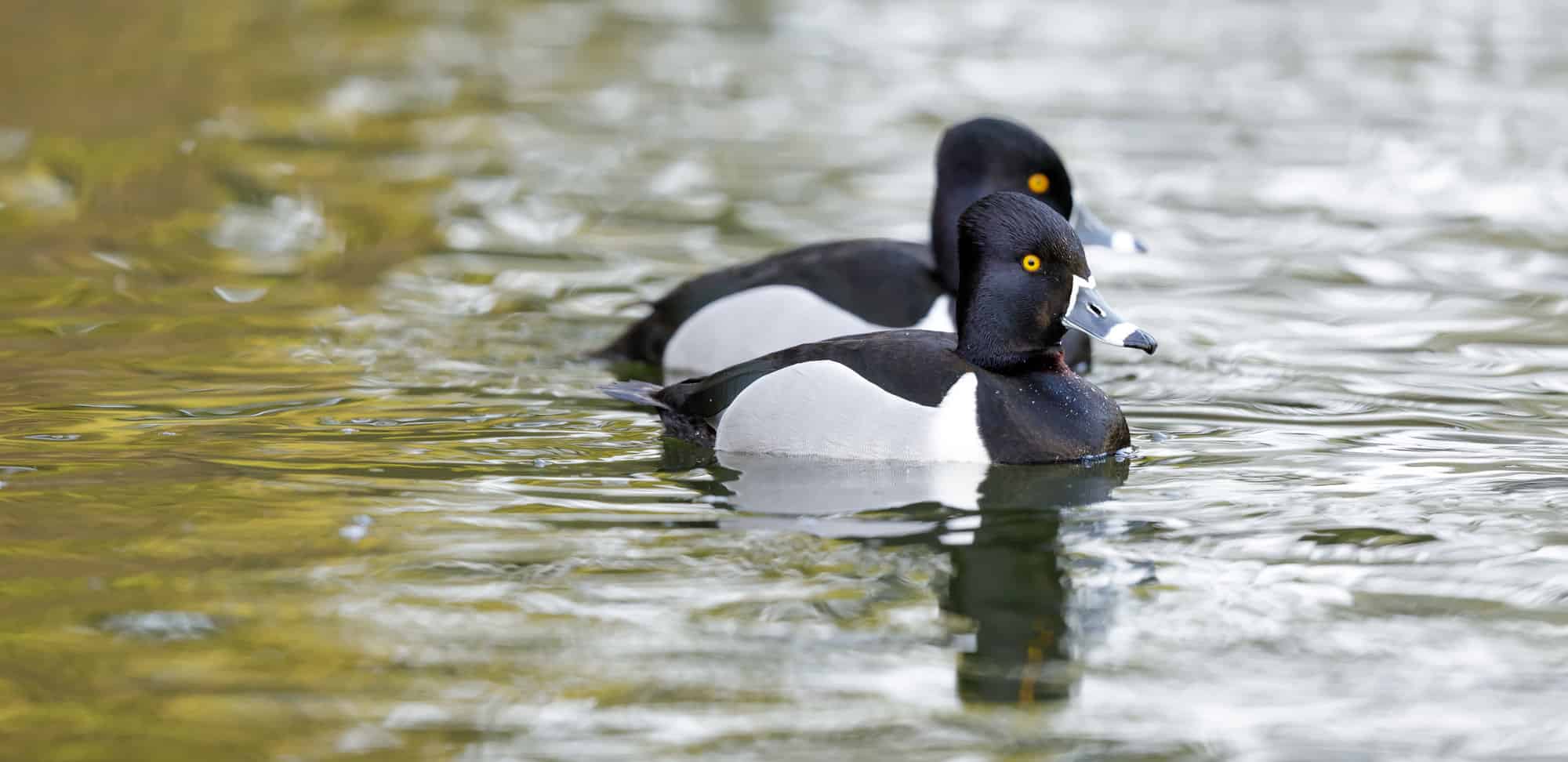
- Scientific Name: Aythya collaris
- Length: 14 – 18 in
- Weight: 21 – 32 oz
- Wingspan: 24 – 30 in
Most of Wyoming only sees passing migrants of Ring-necked Ducks, during their flights back and forth from their northern breeding grounds in the spring and the fall.
In the northwest of the state, however, there are some breeding populations, and other members of the species sometimes overwinter near the southwestern borders.
In the summer, these birds like to spend most of their time in pairs, whereas in winter they can form huge flocks comprising thousands of birds.
Ring-necked Ducks are medium-sized and actually don’t have such a distinctive ring around their neck at all. A more useful characteristic to identify either of the sexes is the white band that runs around their gray bills with a black tip.
Redhead
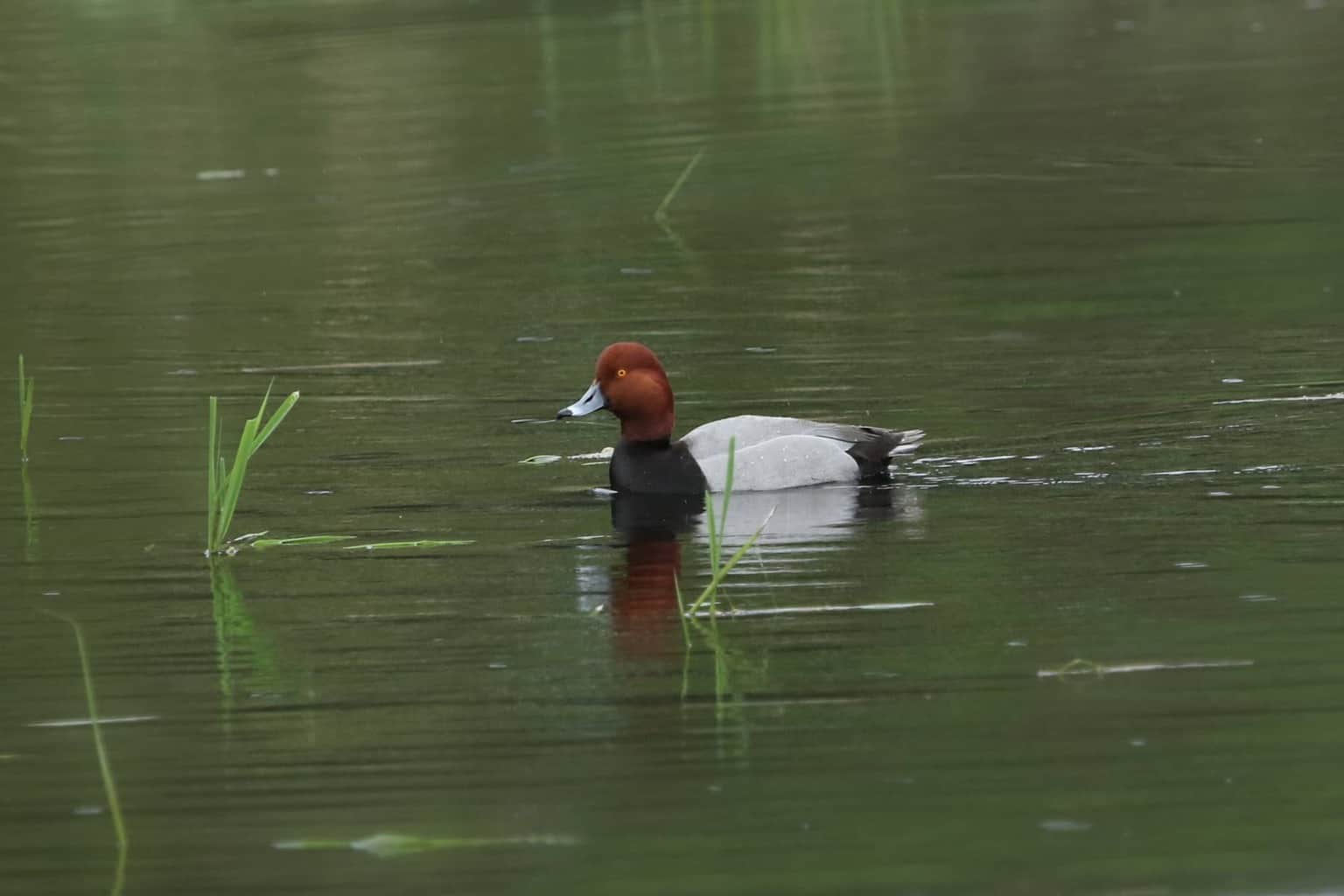
- Scientific Name: Aythya americana
- Length: 18 – 22 in
- Weight: 29 – 41 oz
- Wingspan: 29 – 35 in
Redhead is an appropriate name only for the male of this species, which is a breathtaking duck with a lovely cinnamon red head and golden eyes. The female redheads are a uniform light brown color but can be identified by the black tip on their beaks that’s also present in males.
This hardy duck species can be found year-round in Wyoming but is more commonly spotted in the summer months than in winter.
Redheads are unusual for a diving duck in that they prefer a shallow body of water and rarely go diving for their food. They feed on aquatic plants as well as pond snails, leeches, and worms.
Like a cuckoo, Redheads will sometimes lay their eggs in other ducks’ nests and let the parents raise their young. Interestingly, they’ll also raise their own young too – maybe they’re just making sure!
Bufflehead
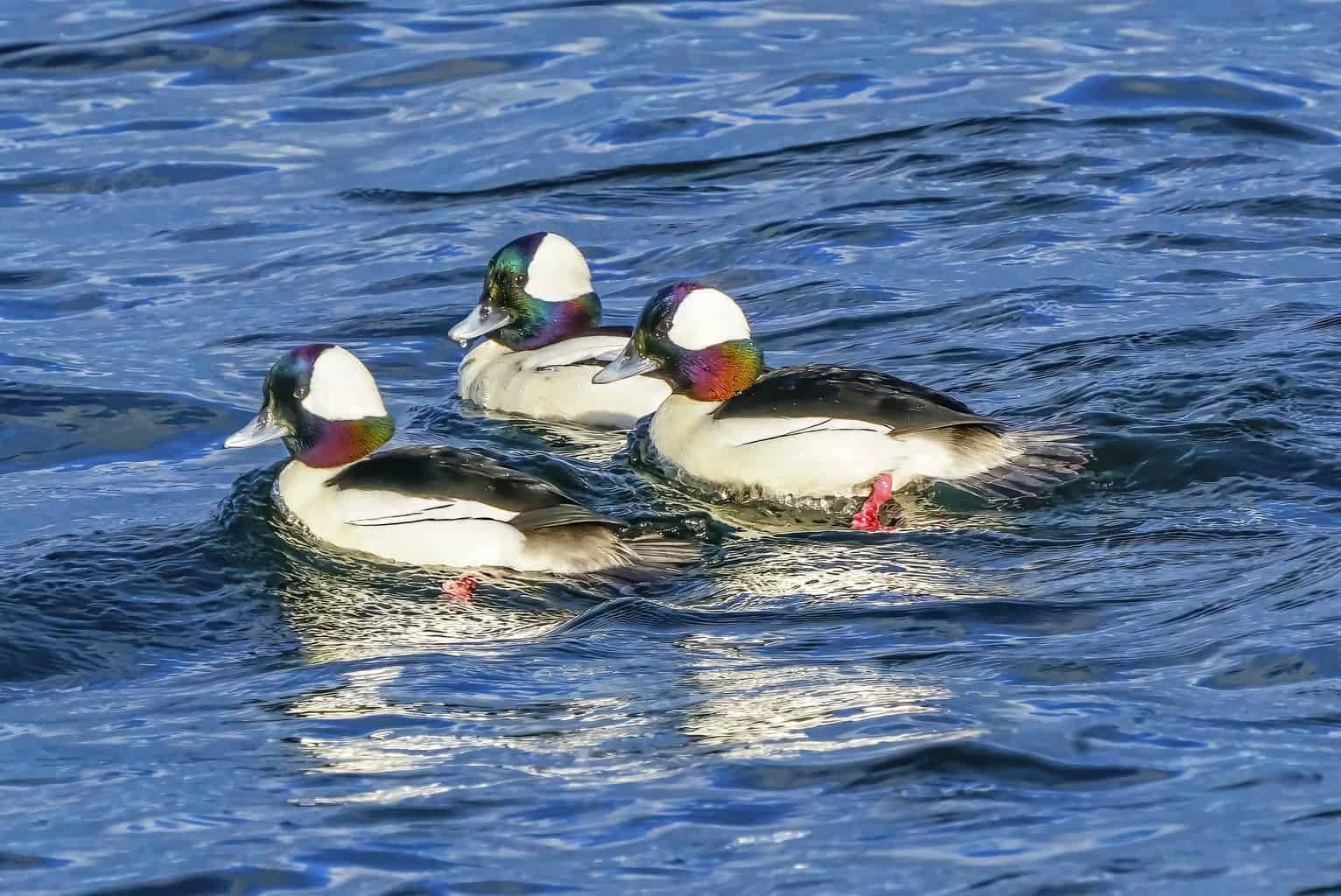
- Scientific Name: Bucephala albeola
- Length: 13 – 16 in
- Weight: 11 – 21 oz
- Wingspan: 20 – 24 in
Buffleheads are small diving ducks that can be seen across Wyoming during the winter months. During the breeding season, however, the birds are confined to just a few parts of the state, especially Yellowstone National Park.
Male Buffleheads are easy to recognize by the iconic large white patches behind their eyes. This is beautifully offset by their dark glossy green and purple forehead and neck.
Females also share a dark head, with their white patch occupying just a small patch of their cheeks.
Buffleheads love diving and are largely carnivorous, feeding on insects, crustaceans, and mollusks. They even consume much of their prey while still underwater!
Northern Pintail
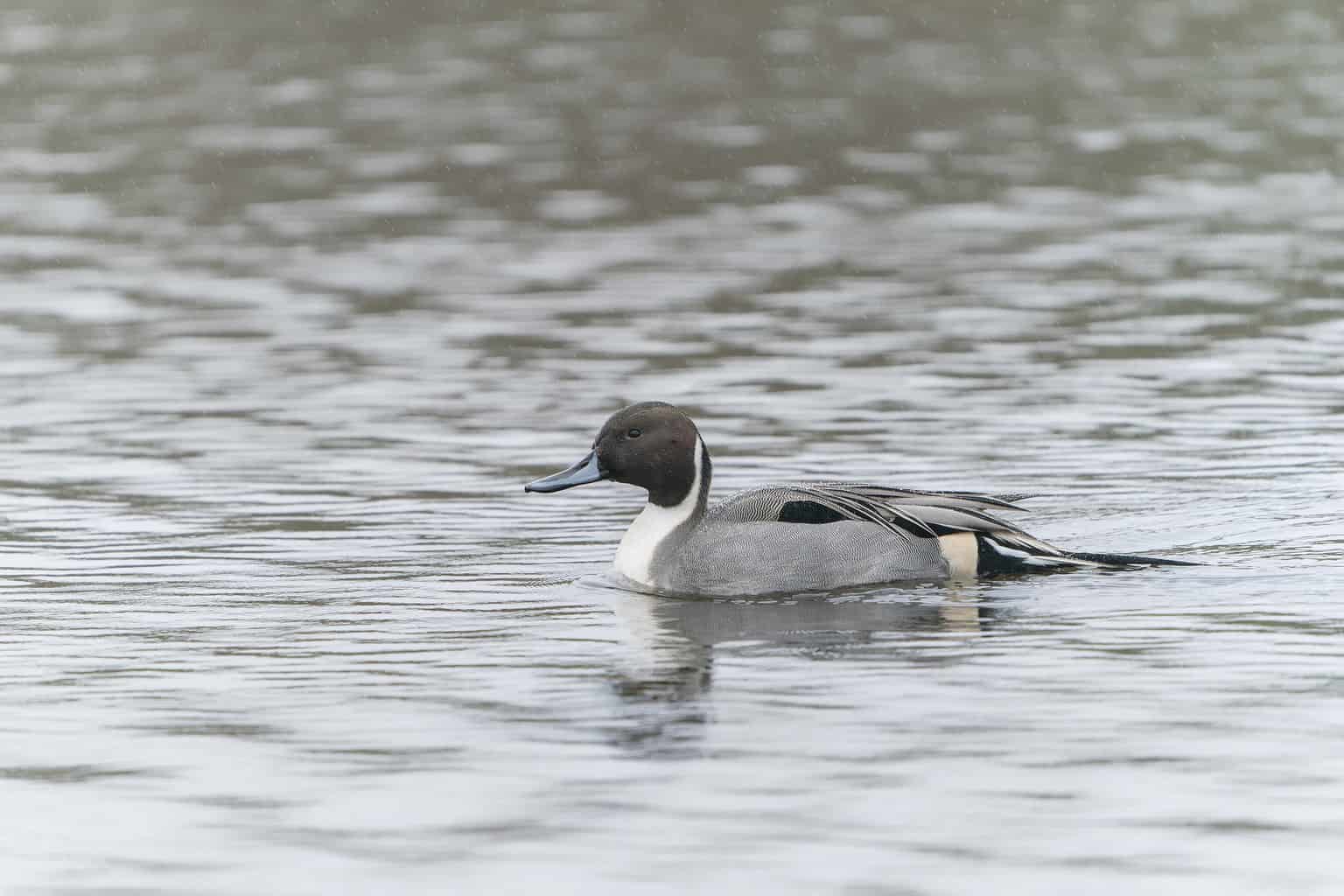
- Scientific Name: Anas acuta
- Length: 20 – 26 in
- Weight: 25 – 36 oz
- Wingspan: 29 – 35 in
Northern Pintails are slender dabbling ducks that are highly agile in air, land, and water. The jet-black head with dark eyes and a white streak on the back of the neck is quite distinctive in males, as are the characteristic long tail feathers that give them their common name.
They breed over the entire state of Wyoming but tend to just stick to the western edge of the state during the winter. Northern Pintails are hardy birds, with some individuals breeding in the northern reaches of Alaska and even Greenland.
The typical feeding habitat for Northern Pintails is in the shallow edges of lakes and ponds, but they can also sometimes be found gleaning the leftovers from cereal fields.
Canvasback
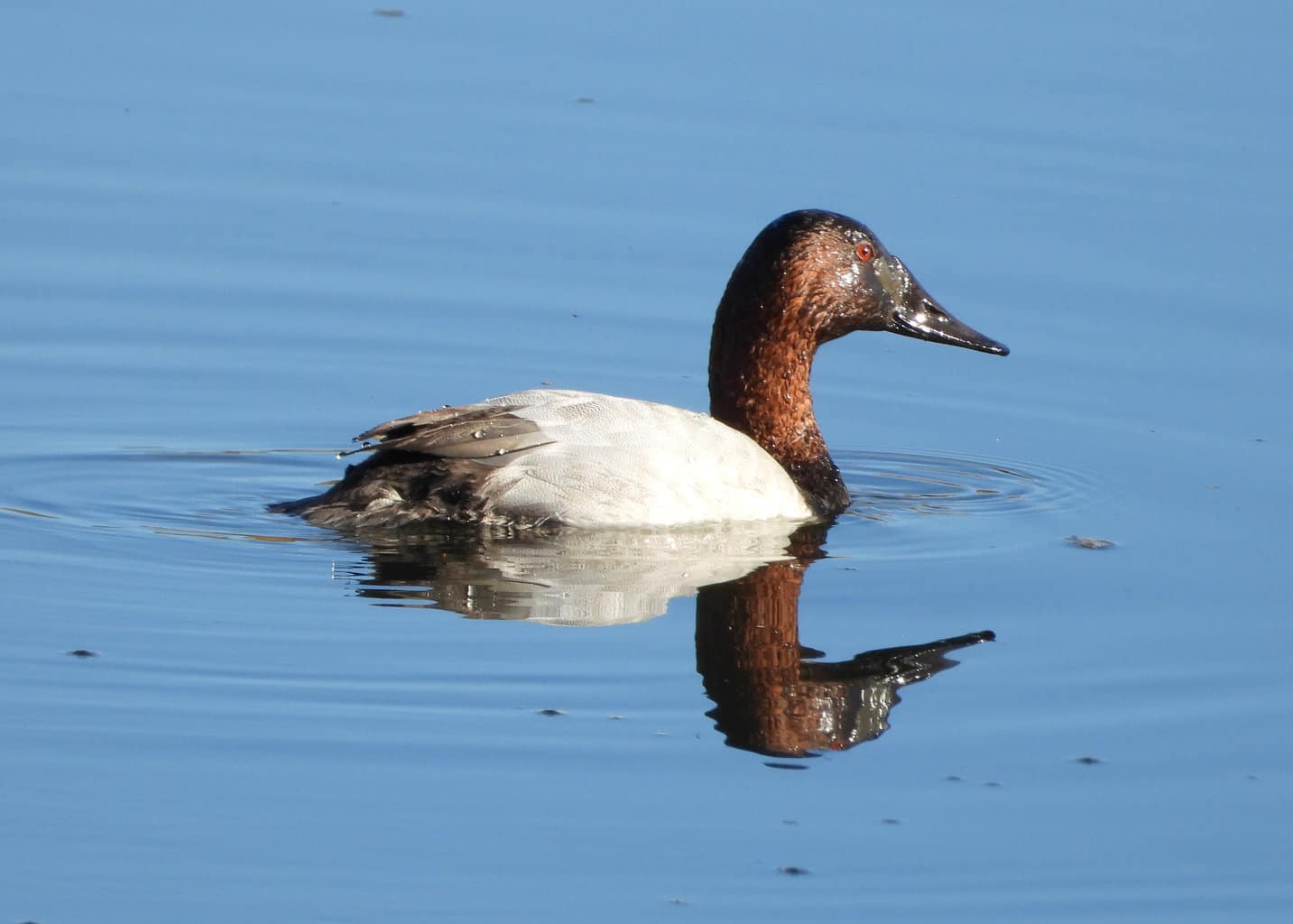
- Scientific Name: Aythya valisineria
- Length: 19 – 24 in
- Weight: 36 – 58 oz
- Wingspan: 28 – 36 in
Canvasbacks breed in relatively few states in the US, but the western and southern parts of Wyoming are graced by breeding pairs of these beautiful birds every year.
The males are very easy to recognize with reddish heads and throats, bright red eyes, and muted gray-white backs. The red eyes and head are lacking in the females, but they still come with the canvas-white back.
Canvasbacks can be found on deep-water lakes as well as prairie marshes and ponds. These diving ducks are highly omnivorous and will eat just about any aquatic food they can find, although plant roots are a favorite.
Wood Duck
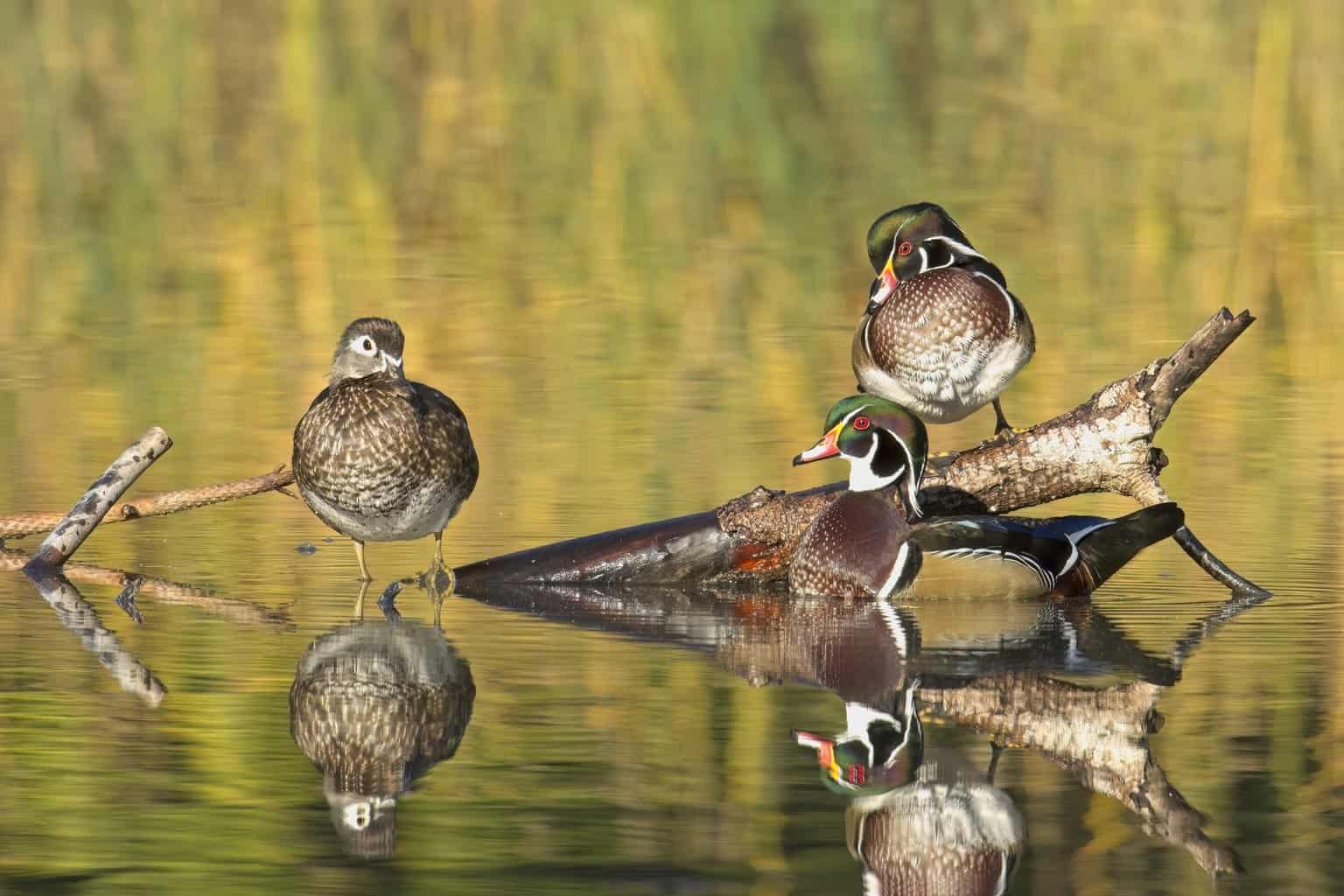
- Scientific Name: Aix sponsa
- Length: 18.5 – 21.3 in
- Weight: 16 – 30 oz
- Wingspan: 26.0 – 28.7 in
You have reason to be excited if you see a Wood Duck in Wyoming. According to checklists, they’re only spotted by 1 in every 70 bird watchers in the summer and far less than that in the winter months.
This beautiful duck is incredibly colorful and looks a bit like a caricature. The male has a gorgeous green crested head, with a red eye and beak. The females are also very pretty with a white patch around their eye, a brown tufted head, and blue feathers on their wings.
The wood duck is also very impressive in its breeding habits. This species likes to nest in tree cavities, and sometimes as high as 50 feet high! This means that each bird must start their life with a dramatic leap of faith from the tree all the way down to the ground, before following its mother across the treacherous forest floor towards the relative safety of the water.
Harlequin Duck
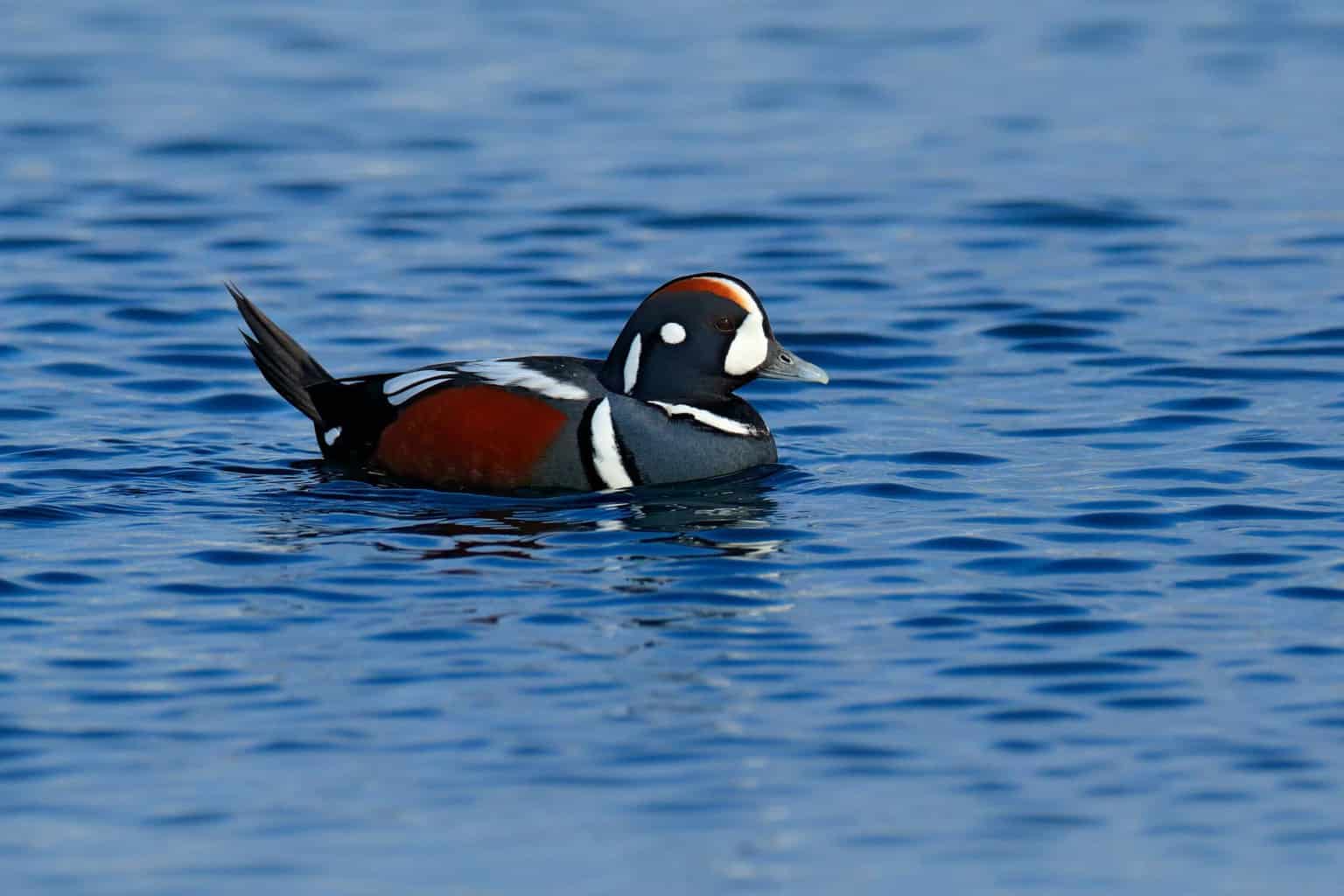
- Scientific Name: Histrionicus histrionicus
- Length: 15 – 21 in
- Weight: 12 – 24 oz
- Wingspan: 26 – 28 in
Harlequin Ducks are surely one of the most striking ducks in America – and it’s extra special to see them in Wyoming. These birds normally reside near the coast but a small number of pairs fly inland to breed in and around Yellowstone National Park.
The Wyoming Game and Fisheries Department (WGFD) estimated a minimum of 70 breeding pairs of Harlequin Ducks in the state, after monitoring the species between 2008-2012. A treasured species in Yellowstone indeed.
Also known as ‘Painted Ducks’ – Harlequins are famous for their extreme choice of habitats! They can often be seen swimming in the rough surf of the Pacific Coast, but seem to accept the white water rapids of streams and rivers in the Rocky Mountains too!
These small sea ducks make more of a mouse-like squeaking sound than a quack. Something to listen out for if you’re around fast-flowing water in Yellowstone during the summer.
Common Goldeneye
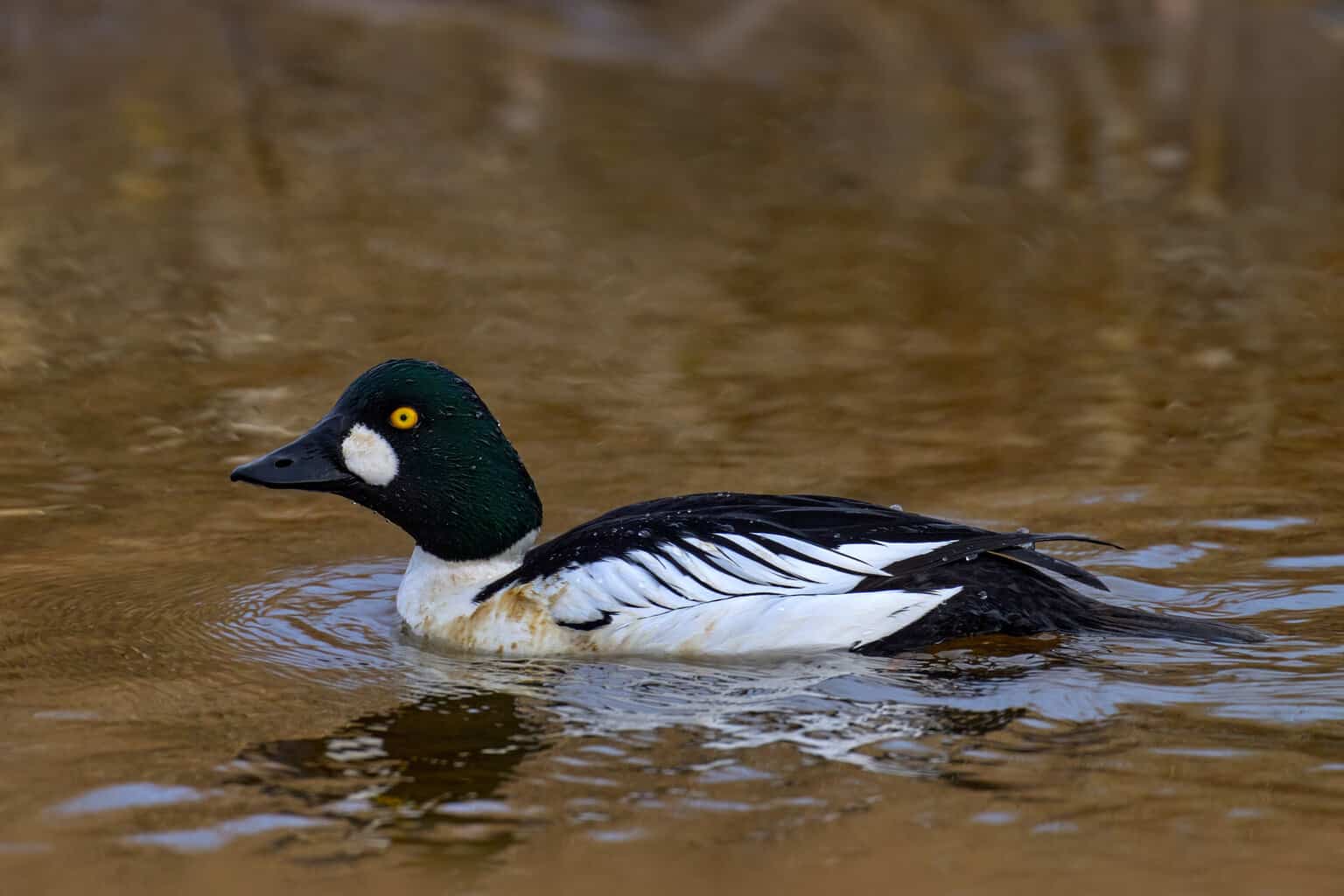
- Scientific Name: Bucephala clangula
- Length: 15.8 – 20.1 in
- Weight: 21 – 45 oz
- Wingspan: 30.3 – 32.7 in
Common Goldeneyes are seen much less readily in Wyoming during the summer than Barrow’s Goldeneyes, but during the winter they are the most common species of any duck found in the park, other than Mallards.
Most Common Goldeneyes choose to breed in Canada and migrate back to the US for the winter, but Wyoming is one of the few states where some of these birds remain all year round.
Similar to Barrow’s Goldeneyes, males have green-black heads and a white spot behind their bills. They have a beautifully contrasting white body with barred, black backs. Females are gray-brown with brown heads and yellow tips on their bill which is lacking in males.
When feeding, all of the birds in one part of the group sometimes dive at the same time. They enjoy feeding on fish, crabs, shrimp, crayfish, and insects.
Common Goldeneyes tend to form small flocks that are fast in flight. On the wing, their wings make a whistling sound which has earnt them their other common name: ‘Whistlers’.
Hooded Merganser
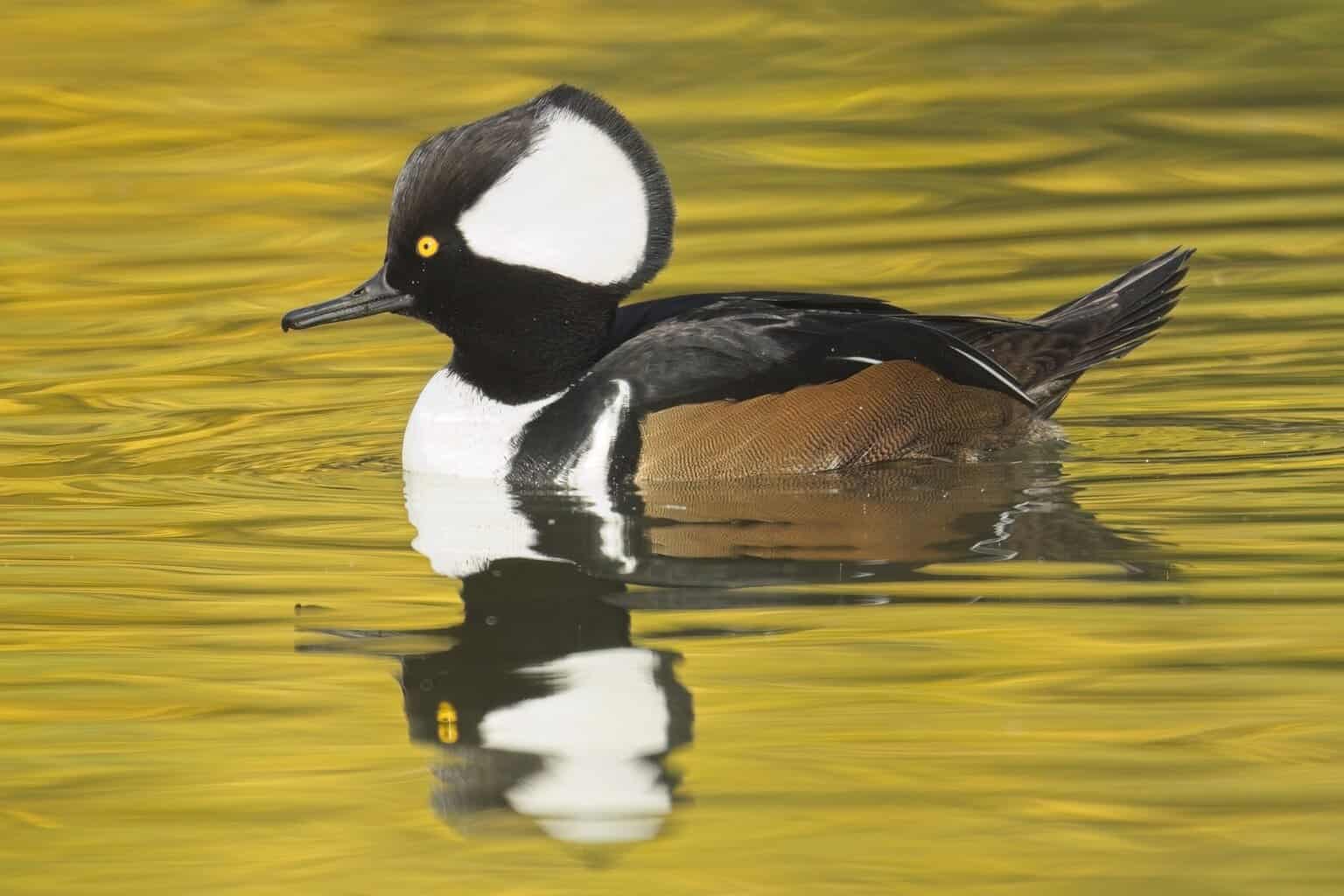
- Scientific Name: Lophodytes cucullatus
- Length: 16 – 19 in
- Weight: 21 – 32 oz
- Wingspan: 24 – 26 in
Hooded Mergansers are normally only considered passing migrants in Wyoming, although a few may occasionally settle in Yellowstone National Park over the winter. You can consider yourself very lucky if you spot one!
Hooded Mergansers are beautiful little ducks with long, slender beaks. Breeding males have an impressive black crest with a white patch on either side and small, yellow eyes. Females also have a brown, tufted crest that looks rather like a Mohican!
In the winter season, the male’s plumage changes dramatically to something more akin to the female’s. Therefore you’re unlikely to see the male in his full glory in Wyoming unless you happen to spot a migratory bird in the spring.
Three Rarely-spotted Duck Species In Wyoming:
Red-breasted Mergansers (Mergus serrator) and White-winged Scoters (Melanitta deglandi ) are very unlikely to be seen settling in Wyoming state but may be spotted passing through during the spring and fall migratory seasons.
Male Red-breasted Mergansers can be recognized by their green, spiky crests, white collars, and orange beaks, whereas White-winged Scoters are distinguished mainly by their sheer size and large white patches on the wings. These huge, brown ducks have been known to exceed 60 oz in weight!
With the long tuft extending from their shiny black heads, Tufted Ducks (Aythya fuligula) are more well-known in Europe and Asia than in America, but will occasionally migrate to the Pacific coast during the winter. If you spot one inland in Wyoming, be sure to report it to the Wyoming Birds Record Committee which has already confirmed a few sightings of these exotic birds.
Conclusion
In Wyoming, it’s possible to see at least 23 species of ducks – an impressive number for any state.
Whether you’re visiting boggy marshes, mountain lakes, domestic ponds, or even whitewater rivers and streams, you’re likely to see some of the beautiful waterfowl listed above.
To learn more about other amazing bird species in Wyoming, be sure to check out our guide to wild birds in the state here.

